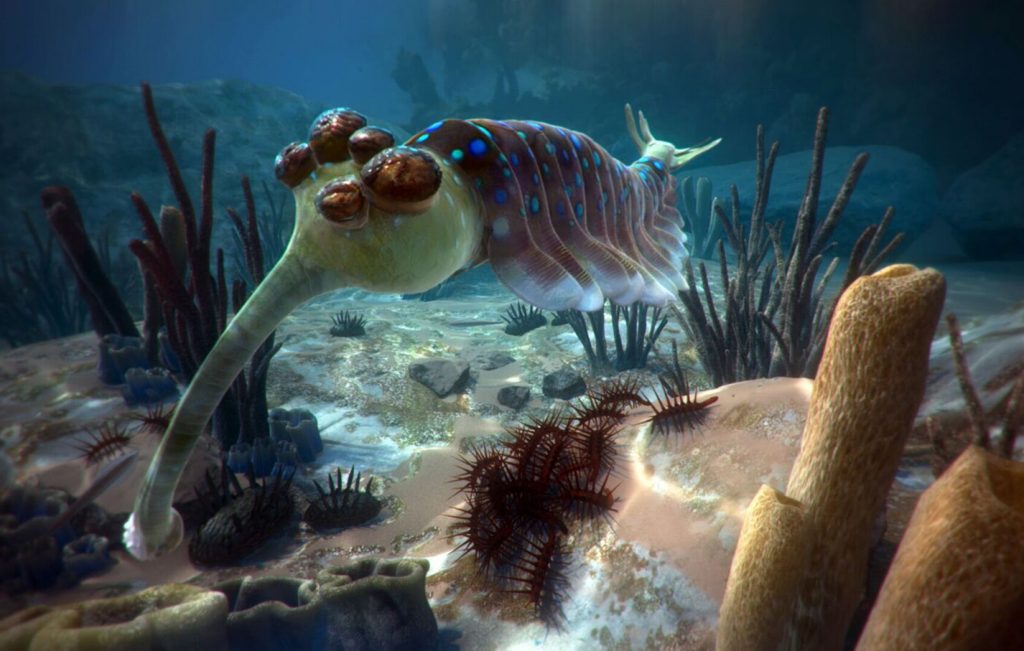VR brings ancient critters back to life
By Sarah Kazak
The Canadian Museum of Nature is hosting the North American premiere of a virtual reality exhibit that allows visitors to immerse themselves into Cambrian Ocean from 500 million years ago, when complex organisms first appeared on Earth.
“David Attenborough’s First Life VR,” is a 10-minute immersive experience that lets viewers interact with extinct sea creatures such as the five-eyed Opabinia, the fearsome-looking Anomalocaris, and the spiny, worm-like Hallucigenia.
Some of these creatures are known from fossilized specimens recovered at British Columbia’s Burgess Shale fossil site, a world-class paleontological reserve that preserves a wide range of extinct animal life from the Earth’s Cambrian era.
“First Life is a unique, high-quality virtual reality experience that cannot be viewed anywhere else in Canada,” said Philippe Lozier, vice-president of content and services at Samsung Electronics Canada. “Sir David Attenborough guides viewers 540 million years back into Earth’s history to explore the dawn of life within a fully immersive 360-degree 3D environment.”
The exhibit, which debuted at London’s Natural History Museum, took about a year to create, said Emily Smith, director of marketing at Atlantic Productions. It was produced by Alchemy VR, a virtual reality studio founded and chaired by Atlantic Production’s CEO and creative director Anthony Geffen.
The CGI creatures, which were modelled from fossil records and with input from world-renowned scientists, were created by the Emmy-Award-winning team at Zoo VFV, a company within Atlantic Production, said Smith.
The Samsung Gear VR, developed and manufactured by Samsung in collaboration with Oculus, is the mobile virtual reality headset used in the exhibit.
“When in use, a compatible Samsung Galaxy smartphone device acts as the headset’s display and processor, while the Gear VR unit itself acts as the controller,” said Lozier.
The Gear VR headset also features a touchpad and back button on the side, as well as a proximity sensor to detect when the headset is on.
“When the Canadian Museum of Nature approached us and explained what they were looking to do, we were immediately intrigued,” said Lozier. “We are committed to enhancing the lives of Canadians by getting them closer to their passion in the most immersive ways and providing our industry-leading Gear VR devices to this initiative does just that.”
“We are always trying to offer new experiences in order to bring our collections to life in different ways for different audiences,” said Angeline Laffin, director of visitor experience at the McLeod Street museum. “So this exhibit was a really good fit.”
However, said Laffin, what makes this exhibit even more exceptional is the fact that visitors can use the virtual reality headset in different parts of the museum.
“The really neat thing about this is that the (virtual reality) experiences are taking place in our different galleries — for example, last weekend we had the experience in the water gallery,” she said.
“It really is something incredibly unique, because even if you were to go to a movie theatre or somewhere that had VR, you wouldn’t have the experience of actually being in a setting like this.”
The exhibit, which has been showcased in museums worldwide, opened on March 23 in Ottawa and runs on Thursday evenings and on weekends until
June 4.
Participants must be 13 years of age or older to use the virtual reality headset.
“This is the first virtual reality experience at the museum that is offered systematically to the public,” said Laffin.
“We are doing it for a limited time so that we can evaluate it and tweak it as we go to see where we can expand it and hopefully grow it in the future.”

